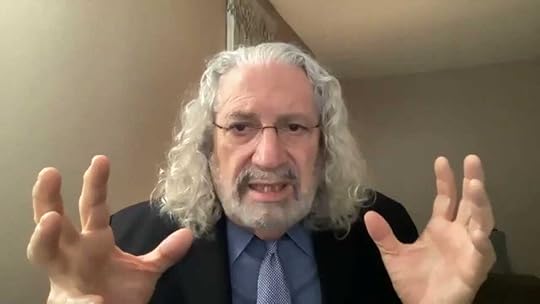Even in the Eschaton, We Must Say Thanks

Tamed Cynic is a reader-supported publication. If you appreciate the work, consider joining the posse of paid subscribers!
“All sacrifices, everything that's written about in the Hebrew Bible will be abrogated. None will require our attention except one, the Hodah, the Thanksgiving sacrifice. I think it's a profound lesson that even when everything is perfect, which it will be when the Messiah comes again. We have to say thank you.”
Happy Thanksgiving to all of you in this community.
Here is the latest installment in a new friendship for which I am grateful this holiday. To begin, Rabbi Joseph talks about the sacrifice of thanksgiving abiding even in the eschaton.
I’ve included an article on archaeologists working to identify remains in Israel after the 10/7 massacre by Hamas:
Wearing gray gloves and with a soot-blackened face, Dr. Joe Uziel shakes the thin mesh screen, which rests on four legs and has a tub-like receptacle underneath. His movements recall the sifting of flour or separating wheat from chaff.
Uziel is not a miller or farmer, though. He’s an archaeologist, the head of the Dead Sea Scrolls unit in the Israel Antiquities Authority, and the tool he’s using is an archaeological sifting screen to separate tiny fragments from soil. 'We are working according to archaeological methods of uncovering strata. But we’re not sifting through strata that are tens of thousands years old.'
The sifters team of sifters he oversees spread out on the partially trampled lawn of Nir Oz, opposite several one-story buildings that were destroyed or burned along with their occupants during Hamas’ October 7 assault on the kibbutz and other nearby communities.
Dr. Joe Uziel in kibbutz Nir Oz, this week. 'This is a difficult task for us emotionally, but important professionally.'Credit: Yossi Melman He and the reservist troops who have been assigned to assist him have a sacred mission: trying to identify the possible remains of any missing victims. “This is a difficult task for us emotionally, but important professionally,” he says. “We enter the burned houses, collect the ashes, and try to find fragments of teeth or bone or any part or item that could help with identification.”
Israel's dead: The names of those killed in Hamas massacres and the Israel-Hamas war Families of Muslim hostages held by Hamas: 'This isn't a religious war' Nir Oz wasn't a battle, It was a systematic massacre Oren Shmueli, his teammate, says, “We are working according to the archaeological methods of uncovering strata. But this time, we’re not sifting through strata that are thousands or tens of thousands years old, but rather from just the past weeks, made of houses whose roofs collapsed and rooms that imploded.”
The archaeologists arrived in Nir Oz after working in the kibbutzim of Be’eri, Kissufim, and Kfar Azza and the convoy of destroyed and abandoned cars from the Nova Music Festival beside Re’im. Their findings are sent to the Shura military base south of Ramle, which serves as a center for the Military Rabbinate and the National Center of Forensic Medicine. The scientists there extract DNA from the findings and cross-check against the database of names of those still missing since the attack.
An empty dining table at Nir Oz's shared dining hall with posters of kibbutz members who are missing following the Hamas attack.Credit: Yossi Melman. The devastation at Kibbutz Nir Oz after Palestinian terrorists infiltrated the kibbutz, murdered many of its inhabitants and burned down their homes.Credit: Hadas Parush Uziel and Shmueli say that the archaeologists’ devoted efforts have led to the identification of 10 victims, allowing them to be declared deceased and brought to burial.
The kibbutz dining hall is just a two-minute walk from where Uziel is working. It’s remained practically untouched since Black Saturday, with shattered dishes, bits of food, and ripped towels soaked with congealed blood still on display, sounding a silent yet piercing howl for the slaughtered, kidnapped, and missing. This is where journalists, primarily from the foreign media, have been brought to bear witness.
Nir Oz, was founded on the Gaza border in 1955 by the Hashomer Hatza’ir movement. Relative to its population, it suffered one of the deadliest attacks on communities in the south. More than a quarter of its population of 400 fell victim – 38 people were murdered and 75 abducted (nearly a third of the total number of hostages), including 16 children; two additional hostages, Yocheved Lifschitz and Nurit Cooper, have been released by Hamas a few weeks ago. Kibbutz spokesman Nitai Ladani says the kibbutz has decided not to distinguish between the hostages and the missing.
In the communal dining hall, the chairs have been covered with white cloths with the pictures and names of those killed and taken hostage attached, making the dimensions of the devastation wreaked on the kibbutz all the more palpable.
Natalie Madmon, sitting next to a picture of her mother, 77-year-old Ophelia Roitman, who is among the Hamas hostages. I was accompanied on this tour by Natalie Madmon, who sat down on the chair with a picture of her mother, 77-year-old Ophelia Roitman. A mother of three and grandmother of nine, Ophelia is among the hostages. “My mother was a teacher her whole life,” says Natalie. “She loved life and she loved the kibbutz and she was a woman of peace.”
The recruitment of archaeologists to help identify the missing and dead was a last-ditch effort to continue the search after the volunteers from the Zaka organization (Hebrew abbreviation for Zihuy Korbanot Ason, lit. 'Disaster Victim Identification') finished their work and couldn’t find any more human remains or bloodstains from which DNA could be extracted. No single entity is in charge of the identification of the dead and missing, and there is no central body handling the information. The numbers are not as updated as they could be, and too many separate entities operate independently without any coordination.
All in all, nine bodies are involved in this effort: the Israel Police, the IDF (including the Military Rabbinate, the Home Front Command, and the Eitan unit for locating missing soldiers), the Religious Services Ministry, Zaka, the Israel Antiquities Authority, the Health Ministry (including hospitals and the forensic institute), the Interior Ministry, the National Insurance Institute, and. the National Public Diplomacy Directorate (part of the Prime Minister’s Office).
After remains or artifacts – articles of clothing, ID cards, passports, necklaces, watches, or other common identifying signs – are collected in the field, they are transported to Shura, run by the Military Rabbinate, the Home Front Command, and the chief medical officer. This is where the initial work of identification takes place.
In the first two weeks of the war, the operation at Shura was beset by overwhelming shock and uncertainty. Hundreds of bodies were being brought in, along with thousands of partial remains. A wide variety of items needed to be sorted to see if they were human remains and to differentiate between the remains of Israelis and terrorists. Numerous volunteers were recruited to assist in the effort, including physicians – especially pathologists and dentists. All were asked to sign confidentiality agreements.
Things didn’t go so entirely smoothly after that initial period. Some of the data was recorded more than once. The bodies and partial remains were sent to nearby Shamir Medical Center for CT scans. The Health Ministry later had a dental CT machine brought to Shura from Hadassah University Hospital, the only one in Israel. The final, definitive identification is made at the forensic institute, which takes biopsy samples and looks for a DNA match. In the case of infants under the age of four months, the tests are done using data from the Health Ministry’s newborn screening program.
Given the large number of disparate entities involved in this crucial work, it would likely have been beneficial had a single overarching director been appointed to coordinate the effort and maximize its accuracy and efficiency.
Perhaps this is one lesson for the future.
In the first days following the Hamas assault, the number of dead was said to be 1,400. This was a preliminary estimate. But now, more than six weeks later, the figures are still hazy. As of Wednesday, according to a spokesperson for the Israel Police, 859 civilian casualties have been identified. This figure includes the 60 members of the police who were killed in combat in the first days. But of this total, only 750 have been buried so far. When I asked Police Spokesman Ami Ben-David about this discrepancy, he cited two reasons. First, he said, some of the dead were foreigners whom no one has come to claim, while others died in the hospital, were identified by relatives, and buried without Shura having been involved. Second, the Israeli Arab victims – both Muslim and Christian – did not have a Jewish burial under the auspices of the rabbinate. Putting together all of the figures I could obtain and whatever answers and explanations I could get from government ministries – and this was no easy task – does allow for an estimate of the death toll.
The total number of murdered civilians and the fallen troops, (so far 370) in Gaza, in the North along the Lebanese border and the West Bank as well as, the 240 hostages stood at 1,510. This number could change, of course, as the war continues and depending on the fate of the missing.
— Yossi Selman
 Get more from Jason Micheli in the Substack appAvailable for iOS and AndroidGet the app
Get more from Jason Micheli in the Substack appAvailable for iOS and AndroidGet the app
Jason Micheli's Blog
- Jason Micheli's profile
- 13 followers



